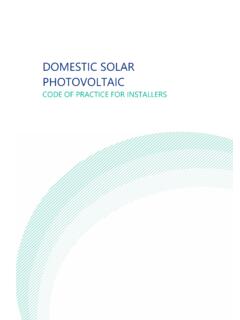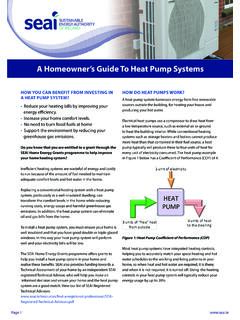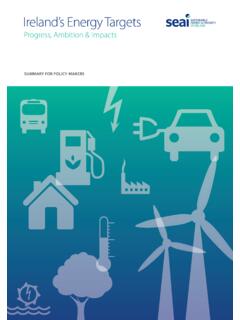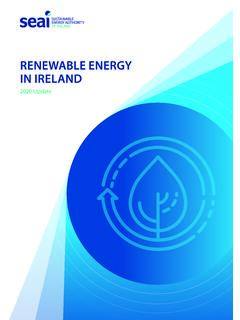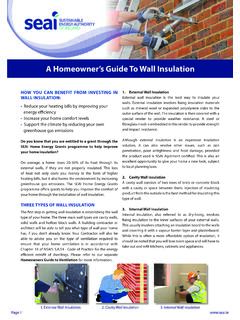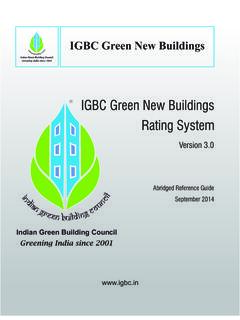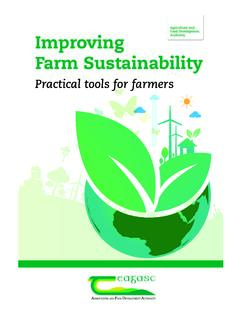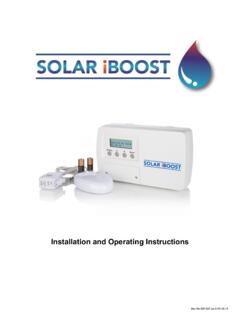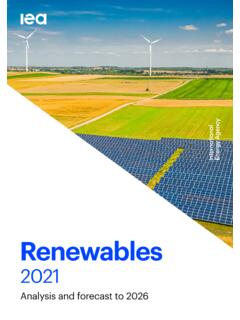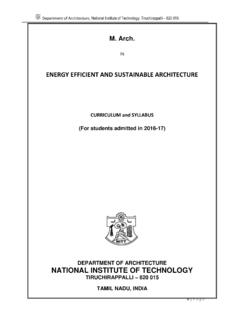Transcription of Best Practice Guide Photovoltaics (PV)
1 Best Practice Guide Photovoltaics (PV)Best Practice Guide Photovoltaics (PV)2 Best Practice Guide Photovoltaics (PV)Acknowledgements:This Guide was adapted from Photovoltaics in Buildings A Design Guide (DTI), Guide to the installation of PV systems 2nd Edition the Department for Enterprise DTI/Pub URN 06/1972. Note to readers:One intention of this publication is to provide an overview for those involved in building and building services design and for students of these disciplines. It is not intended to be exhaustive or definitive and it will be necessary for users of the Guide to exercise their own professional judgement when deciding whether or not to abide by it. It cannot be guaranteed that any of the material in the book is appropriate to a particular use.
2 Readers are advised to consult all current Building Regulations, EN Standards or other applicable guidelines, Health and Safety codes, as well as up-to-date information on all materials and products. Best Practice Guide Photovoltaics (PV)3 Best Practice Guide Photovoltaics (PV)3 Index1 Introduction .. 42 What are Photovoltaics ? .. Introduction .. PVs .. How much energy do PV systems produce? .. Location, tilt, orientation and output .. Over shading and temperature .. 193 PVs on buildings .. Introduction .. The Brief .. Site considerations .. Building type .. Design and construction .. Forms and systems .. Roof-based systems .. Facade systems .. What difference do PVs make? .. 324 Costs and sizing .. Introduction.
3 Costs .. Sizing the array .. The future of costs .. 395 PVs in buildings .. Introduction .. Grid-connection and metering .. System considerations .. Modules and cables .. Plant / Equipment Rooms .. 486 Case Study .. Introduction .. Site and brief .. Design development .. Future detailed design .. Project data .. 617 Appendix A .. 628 References and Bibliography .. 699 Glossary .. 6910 Illustration Acknowledgements .. 7011 Contact .. 70 Best Practice Guide Photovoltaics (PV)41 Introduction If the 19th century was the age of coal and the 20th of oil, the 21st will be the age of the sun. solar energy is set to play an ever-increasing role in generating the form, and affecting the appearance and construction, of buildings.
4 The principal reason for this is that photovoltaic (PV) systems which produce electricity directly from solar radiation are becoming more widespread as their advantages become apparent and as costs fall. PVs are an advanced materials technology that will help us design buildings which are environmentally responsible, responsive and exciting. PV installations can take a variety of forms as shown in the following figures. Best Practice Guide Photovoltaics (PV)5 There are many applications for PVs and some are already in widespread use here in Ireland. Others represent potential uses that are likely to be seen in the near future. These are listed in the table below:End usersTypical ApplicationsWaterway Authorities / Environmental Protection AgencyLock & Sluice operationWater pumpingWater quality monitoringLocal AuthoritiesParking metersCar park security lightingStreet / path lightingBus stop and shelter lightingRoad AuthoritiesEmergency phonesRoadside information and hazard warning signsMobile units for temporary warning signsSpeed camerasRemote junction / crossroads lightingPowered cats eyesTraffic and pollution monitoringRail NetworkRemote rail stations lightingPoint greasersSignalling and warning signsHarbour & Light House AuthoritiesLighthousesOffshore (buoy-mounted)
5 Navigation beaconsHarbour navigation beacons and warning signsMet OfficeWeather stations wind speed, temperature etcAir quality monitoringHeritage and National Monument SitesRemote visitor centresYouth HostelsRemote hostelsUniversities / Research LaboratoriesRemote monitoring equipmentGas / Electricity / water Utility Companies / SuppliersRemote meter readingPressure and flow measurementValve operationAnti-freeze heatingMonitoring HV cable insulationWater level measurementWater treatment, pumping and purificationPhone Network OperatorsMobile phone local transmittersTelecoms repeater stationsFarming & AgricultureElectric fencingPest control flashing lights, bird scarersWater pumping for livestock & drinking waterLighting for stables and out-housesFish farm pond aerationFish farm feeding systemsGreenhouse lighting and heatingBest Practice Guide Photovoltaics (PV)6 End usersTypical ApplicationsDomestic BuildingsLighting and general powerIndustrial BuildingsLighting, general power and process equipmentGeneralAlarms for remote buildingsArea lightingCCTVA dvertisingLeisure BoatsElectric boat battery chargingBattery charging (lighting & TV)Camping & Remote HomesBattery charging (lighting & TV)Commercial BuildingsLighting and general powerTable : Typical applications of photo voltaic technology1 Many of the applications listed in the table above can be considered small scale.
6 Application of PVs in buildings has a very large potential and this best Practice Guide is focused on this area of can form part of the roof structure, walls or be floor mounted. Different types will lend themselves to different buildings. This Guide provides an overview of how PVs work and are incorporated in the design of buildings; it gives the information that building owners, designers and, in particular, architects, need. It is for those who wish to assess the feasibility of using PVs in a specific project, for those who have already decided to use PVs and want to know how to do so and for those with the foresight to want to plan their buildings for PVs in the future. New buildings have been addressed especially and covered by a number of building types and sectors; much of the technology could be applied as a retrofit to existing buildings.
7 The focus is on PV systems which are building-integrated and grid-connected. PVs are a proven, commercially-available technology. In grid-connected systems, the PVs operate in parallel with the grid, so if the PV supply is less than demand the grid supplies the balance; when there is excess energy from the PV system it can be fed back to the grid. Building-integrated, grid-connected systems have the following advantages: The cost of the PV wall or roof can be offset against the cost of the building element it replaces. Power is generated on site and replaces electricity which would otherwise be purchased through the national grid from utility suppliers. By connecting to the grid the high cost of storage associated with stand-alone systems is avoided and security of supply is ensured.
8 If the facility for selling excess electricity is available, then connecting to the grid will ensure that the high cost of storage associated with stand-alone systems is avoided and that security of supply is ensured. There is no additional requirement for land. PVs should be considered as an integral part of the overall environmental strategy of energy-efficient building design. PVs will be a key element in furthering this approach to building and will help us move towards lower carbon, carbon neutral and carbon negative buildings. 1 Adapted from International Energy Agency Cooperative Programme on Photovoltaic Power Systems Task 1: Exchange and dissemination of information on PV power systems: National Survey Report of PV Power Application in the United Kingdom 2007 (Department for Business Enterprise and Regulatory Reform).
9 Best Practice Guide Photovoltaics (PV)7 This Guide has been produced with Ireland in mind. The Guide deals with its weather conditions. However, as can be seen from Figure , annual irradiation is similar in much of Northern Europe. Figure solar irradiation over Europe (kWh/m2/y) The Guide is set out in a way that mimics the design process: Chapter 2 introduces some basic PV concepts. Chapter 3 discusses the site and building and the design options. Chapter 4 examines costs and sizing. Chapter 5 looks at the integration of PVs inside the building. Included at the end of this Guide is an example commercial case study, an appendix setting out a number of technical points and a glossary of terms commonly encountered in relation to photo voltaics.
10 The Guide is intended to give an idea of the variety and flexibility of PVs and of their design and aesthetic potential; if we as a design community are successful, our local and global environments will be enhanced. Best Practice Guide Photovoltaics (PV)82 What are Photovoltaics ? Introduction PV systems convert solar radiation into electricity. They are not to be confused with solar thermal panels which use the sun s energy to heat water (or air) for water and space heating . This chapter looks at PVs and examines a number of issues of interest to designers including: PV module size and shape. Colour. Manufacturing technology. Environmental issues. Energy production. Best Practice Guide Photovoltaics (PV) PVs The most common PV devices at present are based on silicon.
